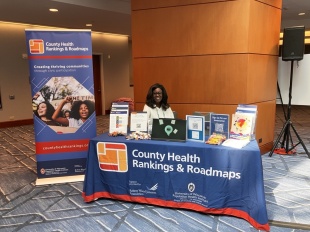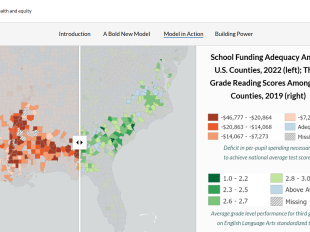2010-2020: What We’ve Learned Ten Years into the County Health Rankings & Roadmaps
It’s been just over a decade since the University of Wisconsin Population Health Institute and the Robert Wood Johnson Foundation released the first nationwide County Health Rankings. Since that release in February 2010, the program has evolved, learning from partner organizations and communities, expanding to offer more evidence-based resources like What Works for Health, and celebrating communities through the RWJF Culture of Health Prize.
We sat down with former County Health Rankings Project Director Dr. Bridget Catlin—and co-author of Ten-Year Reflections on the County Health Rankings & Roadmaps—to learn more about how the Rankings program has grown and to discuss what’s next:
(Interview is edited for length and clarity).
The new Ten-Year Reflections on the County Health Rankings & Roadmaps report details the Rankings program over the past 10 years. How have you seen the program grow and evolve since 2010?
When we released the first Rankings across all 50 States in February 2010, the project was primarily about collecting and aggregating data from other sources and then creating the Rankings. But as we were doing this, we realized releasing data to the more than 3,000 counties across the nation was going to be rather overwhelming. We learned we needed to work closely with the state and local public health departments to prepare them for the Rankings release.
And then after the first year, we discovered we needed to also work with a score of other players in the community health environment. It was that community engagement, led by another former County Health Rankings director and the other report co-author, Dr. Julie Willems Van Dijk, that I attribute a lot of the success to. We worked with people to be able to better understand and use the data and then over time, we added additional tools to help them take the data and put it into action.
How have you seen the County Health Rankings course correct and change to meet communities’ changing needs?
As more and more of the nation and public health leaders realized it was important to understand how health was distributed within counties, there was a push to provide data, not just at the county level, but to break it out within counties so that within a county, for example, you could see how different racial and ethnic groups were doing. By adding that kind of data, which is available on the website, County Health Rankings was able to respond to growing needs.
Since we launched the What Works for Health database in 2012, that tool has continued to evolve over the years to cover more and more strategies. It started off covering around 200 strategies, and now it’s well over 400 strategies. It’s a huge time saver for communities and over the years, we’ve taken suggestions from communities and state and national organizations about the kinds of strategies to add. And since then, those evidence-based resources have continued to expand as we’ve added more tools communities can use for taking action, like the new Action Learning Guides.
And then the Roadmaps to Health Prize, which was later named the RWJF Culture of Health Prize, has become a way of identifying communities that were doing innovative things in the areas of community health improvement, across a wide number of criteria. That program over the years has really been able to highlight the changes that are happening in communities over time and the ways that different communities are handling the many challenges that they face.
Where do you hope to see the Rankings program headed for the next 10 years?
The number one area, which the program is already working on, but that still has a lot more to do, is to expand the County Health Rankings model and approach to better reflect health equity and its drivers. Even though we have some data on the site that supports health equity work, the Rankings model and the Rankings themselves don't reflect how health is distributed within communities. It’s important work and the national climate right now clearly indicates that people are really recognizing that it's not just how healthy people are on average within the community. It's looking at specific populations and understanding how their health is doing, because there are big differences, both by racial and ethnic factors, but also by factors like geographic location and social economic factors.
What’s been the most exciting Rankings moment for you?
The morning of the first release: We had this big release event and the website actually crashed. We kind of knew that if we did our job right, there would be a lot of traffic to the website and we tried to predict this, but none of us could predict the amazing amount of traffic that we had those first couple days. At one point, we were trending in the top three on Google search. It just blew us away that so many people were interested in understanding community health and what goes into it. That probably was the most exciting moment for me, and the excitement, it continued. Every year when we did the Rankings release, we would have this huge boost in activity.
And then also as Julie and I put together the new Ten-Year Reflections report, recognizing how the County Health Rankings has truly been a massive team effort with a lot of input from a lot of people was a powerful moment. When we actually stopped and thought about all the people who’d helped us along the way, it was like wow.
Read the Ten-Year Reflections on the County Health Rankings & Roadmaps executive summary and full report.



